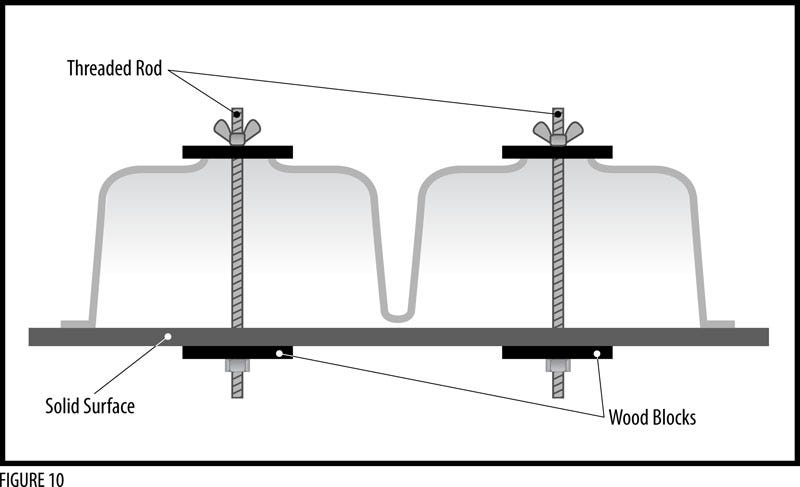Beyond aesthetics, there are functional benefits to having a solid surface undermount sink, versus a top mounted (or drop-in sink.) Undermount sinks are easier to clean and keep hygienic since the barrier around the sink, like the lip for a top mounted sink, is no longer there. Additionally, the seam between the sink and the top is bacteria, stain and water resistant because it is a hardened resin like the rest of the non-porous sink and countertop.
The first step to installing a solid surface undermount sink is to turn the solid surface sheet upside down and locate the place where the sink is to be placed. Then, position the bowl on the surface and use hot melt glue to fasten positioning blocks around the sink to aid in alignment during gluing. Drill a 1-1/4” hole in the top, in-line with the sinkhole, so that you can insert an all-thread rod. The rod, along with nuts and wood blocks (that act like large washers), are used to place a moderate and even amount of pressure on the sink for gluing. (See Figure 10)

Figure 10: Clamping Sink Bowl to Underside of Counter Surface
Carefully remove the sink from it’s marked location. Scuff the undersurface of the top where the sink will sit and the top flange of the sink bowl with 80-grit sandpaper. Clean both surfaces with denatured alcohol. Use a flat sanding block to ensure you don’t round-over the inside edge of the sink when sanding. (See Figure 11)

Figure 11: Preparing Bonding Surfaces
The goal, when gluing a sink in place, is to have the glue line appear perfectly flat. In almost all instances the countertop is true (flat). In these cases, where the rim of the sink is perfectly true, then the glue line will be flat and you can use the adhesive color recommended by the manufacturer for the countertop or the sink.
If the rim of the sink is not perfectly true (flat), then use the adhesive color that is recommended by the manufacturer for the sink. That way, the uneven sink rim will not show, since the adhesive which matches the sink will effectively “disappear” from view. In essence, the adhesive will create a self-leveling effect. The only line that will show will be where the sink matching adhesive meets the underside of the flat countertop, making the glue line appear flat.
This can seem simple enough, however, it is often difficult to find adhesive that matches a sink. Therefore, make sure you sand the sink rim true. Once it is true, then the adhesive matching the countertop can be used. If you do not sand the sink rim flat and go ahead and use the countertop matching adhesive, then an uneven appearing junction between the sink and top can occur.
Next, apply two beads of adhesive to the sink rim; one near the inside edge, making sure there will be squeeze-out all the way around, and the other near the outside edge. Carefully position the sink inside the area of the positioning blocks.
Place the all-thread rod in place with wood blocks and tighten it until you see adhesive squeezing out all around. Even though you won’t be able to see it, you will want to apply enough adhesive so it squeezes in around the inside as well. Do not over tighten as this will “starve” and weaken the seam. Allow the squeeze-out to harden for about 30 minutes or until it is hard to the touch.
Turn the countertop over so the top is facing up. Two different router bits will be used to remove the material from within the bowl opening and provide the edge to the sink. The first is a ½” 2 Straight-Flute bit with a large nylon bearing at the bottom. The bearing has a larger diameter than the bit which will position the cutting edge of the bit back from the inside wall of the sink. This bit will cut away the top and will leave a lip around the inside edge of the sink that will be removed by the second bit. (See Figure 12)

Figure 12: Routing Out Sink Opening
Next, use a Roundover bit with a nylon bottom bearing. This bit will cut a small amount from the edge of countertop and the sink, including the protruding squeeze-out. Position the bit, up and down, so the bearing rides below the seam squeeze-out and the top of the cutting edge clears the countertop surface. (See Figure 13) Pay attention to the router bit rotation to avoid any chatter (vibration or wobbling of the bit due to the high-speed rotation.)

Figure 13: Routing the Finished Sink Opening
Make sure the bevel angle of the Roundover bit is suitable for the bevel angle of the sink. The angle of the sink wall may change as you move around the sink. There may be a slight ridge left in some places after routing. This is expected and can be sanded away with a random orbit sander and 180-grit sandpaper, followed by 280-grit sandpaper.
Make sure the bevel angle of the Roundover bit is suitable for the bevel angle of the sink. The angle of the sink wall may change as you move around the sink. There may be a slight ridge left in some places after routing. This is expected and can be sanded away with a random orbit sander and 180-grit sandpaper, followed by 280-grit sandpaper.
Finally, finish sanding the rounded surface with a random orbit sander and a soft thick backing pad. The pad allows the sandpaper surface to flex and easily follow the rounded edge.
